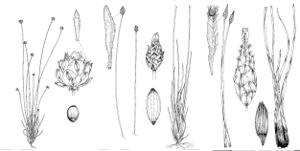Difference between revisions of "Xyris brevifolia"
Flora Boreali-Americana 1: 23. 1803.
FNA>Volume Importer |
imported>Volume Importer |
||
| (6 intermediate revisions by 2 users not shown) | |||
| Line 6: | Line 6: | ||
|place=1: 23. 1803 | |place=1: 23. 1803 | ||
|year=1803 | |year=1803 | ||
| + | }} | ||
| + | |special_status={{Treatment/ID/Special_status | ||
| + | |code=F | ||
| + | |label=Illustrated | ||
}} | }} | ||
|basionyms= | |basionyms= | ||
| Line 11: | Line 15: | ||
|name=Xyris intermedia | |name=Xyris intermedia | ||
|authority=Malme | |authority=Malme | ||
| + | |rank=species | ||
}} | }} | ||
|hierarchy=Xyridaceae;Xyris;Xyris brevifolia | |hierarchy=Xyridaceae;Xyris;Xyris brevifolia | ||
| Line 26: | Line 31: | ||
|elevation=0–200 m | |elevation=0–200 m | ||
|distribution=Ala.;Fla.;Ga.;N.C.;S.C.;West Indies;South America (Brazil). | |distribution=Ala.;Fla.;Ga.;N.C.;S.C.;West Indies;South America (Brazil). | ||
| − | |discussion=<p>Plants in south Florida and Cuba often have longer and narrower leaf blades than is typical, and G. O. K. Malme (1925) named Cuban material Xyris intermedia on the basis of longer, narrower leaf blades and entire sepal keels. In Florida, however, all of these characters intergrade. The red sepal tips, almost a homology with the bract dorsal area, are a constant (yet neglected) character. This species is often weedy.</p> | + | |discussion=<p>Plants in south Florida and Cuba often have longer and narrower leaf blades than is typical, and G. O. K. Malme (1925) named Cuban material <i>Xyris</i> intermedia on the basis of longer, narrower leaf blades and entire sepal keels. In Florida, however, all of these characters intergrade. The red sepal tips, almost a homology with the bract dorsal area, are a constant (yet neglected) character. This species is often weedy.</p> |
|tables= | |tables= | ||
|references={{Treatment/Reference | |references={{Treatment/Reference | ||
| Line 38: | Line 43: | ||
-->{{#Taxon: | -->{{#Taxon: | ||
name=Xyris brevifolia | name=Xyris brevifolia | ||
| − | |||
|authority=Michaux | |authority=Michaux | ||
|rank=species | |rank=species | ||
| Line 52: | Line 56: | ||
|publication title=Flora Boreali-Americana | |publication title=Flora Boreali-Americana | ||
|publication year=1803 | |publication year=1803 | ||
| − | |special status= | + | |special status=Illustrated |
| − | |source xml=https:// | + | |source xml=https://bitbucket.org/aafc-mbb/fna-data-curation/src/2e0870ddd59836b60bcf96646a41e87ea5a5943a/coarse_grained_fna_xml/V22/V22_190.xml |
|genus=Xyris | |genus=Xyris | ||
|species=Xyris brevifolia | |species=Xyris brevifolia | ||
Latest revision as of 21:29, 5 November 2020
Herbs, annual, cespitose, rarely solitary, (4–)10–30(–60) cm. Stems compact. Leaves in fans, 2–10(–15) cm; sheath base greenish to pink; blade green or red-tinged, filiform to linear, 1–4 mm wide, smooth, margins smooth to papillate. Inflorescences: scape sheaths mostly exceeding leaves, blade prominent (in filiform-leaved extremes, overtopped by leaves); scapes wiry, nearly terete, 0.5–1 mm wide, low-ribbed apically; spikes oblate to globose or ovoid, mostly as broad as long, 5–7(–10) mm, apex blunt; fertile bracts 3–6 mm, margins often squarrose, lacerate, scarious, with red inner band, apex broadly rounded. Flowers: lateral sepals included, slightly curved, 3–5 mm, keel firm, nearly entire to papillate or ciliolate, apex reddish; petals unfolding in morning, blade obovate, 2.5–3 mm; staminodes bearded. Seeds amber, broadly ellipsoid, 0.5 mm, finely lined. 2n = 18.
Phenology: Flowering spring–summer(–winter in the south).
Habitat: Acid, sandy, moist savanna and cleared areas
Elevation: 0–200 m
Distribution

Ala., Fla., Ga., N.C., S.C., West Indies, South America (Brazil).
Discussion
Plants in south Florida and Cuba often have longer and narrower leaf blades than is typical, and G. O. K. Malme (1925) named Cuban material Xyris intermedia on the basis of longer, narrower leaf blades and entire sepal keels. In Florida, however, all of these characters intergrade. The red sepal tips, almost a homology with the bract dorsal area, are a constant (yet neglected) character. This species is often weedy.
